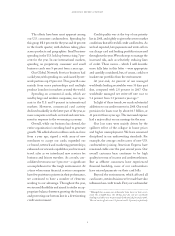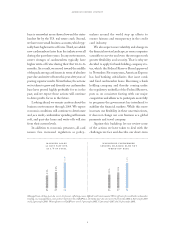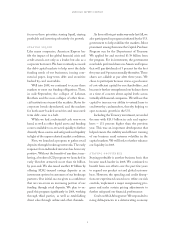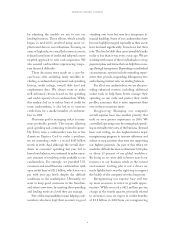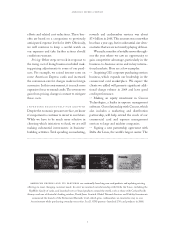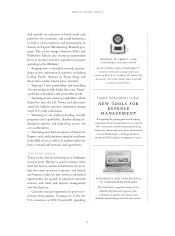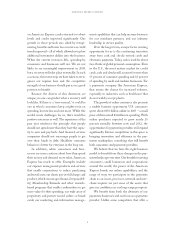American Express 2008 Annual Report Download - page 15
Download and view the complete annual report
Please find page 15 of the 2008 American Express annual report below. You can navigate through the pages in the report by either clicking on the pages listed below, or by using the keyword search tool below to find specific information within the annual report.2008 financial review
american express company
to maintain a higher level of capital in future years. The
Company’s participation in the CPP requires it to suspend its
share repurchase program, except related to its benefit plans and
in other limited circumstances, and not increase its dividends
until the redemption of the CPP investment. Even after the
anticipated redemption of the CPP investment, a capital base
greater than the Company has maintained over the last several
years will lead, all other things being equal, to lower future ROE.
While the Company is not establishing a new target at this
time, it currently believes that it will ultimately be positioned
to deliver an ROE in excess of 20 percent over time. As the
capital markets environment evolves and economic conditions
improve, management will have greater visibility into its capital
requirements. At that time, the Company will provide updated
long-term ROE and capital distribution targets.
bank holding company
During the fourth quarter of 2008, the Company became a
bank holding company under the Bank Holding Company
Act of 1956, and the Federal Reserve Board (Federal Reserve)
became the Company’s primary federal regulator. As such,
the Company is subject to the Federal Reserve’s regulations,
policies and minimum capital standards.
The primary reason for the Company converting to a bank
holding company was to become a Federal Reserve member
and thus have the same status and regulator as a majority of the
Company’s peers. Taking this action allows the Company to
participate more fully in some government programs, providing
greater flexibility during uncertain economic times. The Company
converting to a bank holding company will change neither its
payments focused model nor its core businesses.
As a result of converting to a bank holding company,
the Company has made certain changes to its Consolidated
Statements of Income and Consolidated Balance Sheets and
reclassified certain prior period amounts in order to conform to
the current presentation of its financials in accordance with the
Securities and Exchange Commission’s regulations applicable
to bank holding companies. These changes and reclassifications
within the Consolidated Statements of Income include (i) new
categories of interest income and interest expense, and changes
to the component classifications thereof, (ii) the reclassification
of card fees on lending products from net card fees to interest and
fees on loans, (iii) separate disclosure of certain financial statement
line items, which are presented in Note 23 to the Consolidated
Financial Statements, and (iv) certain other placement and
line title changes. The changes and reclassifications within the
Consolidated Balance Sheets include (i) the breakout of interest
and non-interest bearing cash accounts into separate lines, (ii)
the reclassification of unearned income on loans from other
liabilities to loans as a contra-asset, and (iii) certain other line title
changes. These reclassifications had no impact to the Company’s
consolidated net income.
current economic environment/outlook
During the latter half of 2008, concerns over the availability
and cost of credit, a historic decline in real estate values in the
United States, rising unemployment, and the collapse of major
financial institutions contributed to a worsening global recession,
increased volatility and reduced liquidity in the capital markets,
and diminished expectations for the economy. The Company
experienced slowing cardmember spending (including a year
over year decline in spending in the fourth quarter of the year)
and loan volumes and higher delinquencies as increasing stress in
the worldwide financial markets eroded consumer and business
confidence levels. Based on these trends, the Company expects
consumer and business sentiment will likely deteriorate further
and will translate into weaker economies around the globe and
increased unemployment through 2009. As a result, the Company
will continue to reevaluate its reengineering needs through 2009.
Beyond the economy, all card issuers face increased
regulation as policy makers around the world step up efforts to
ensure fairness and transparency in the credit card industry.
To prepare for this more difficult environment, the Company
moved ahead with plans that resulted in reengineering charges
in the fourth quarter of 2008. (See further discussion in the
Reengineering Initiatives section below). The Company also
began implementing a number of selective pricing increases
in connection with certain of its products to help mitigate
the Company’s increased costs to extend credit. Through a
combination of cost reductions and revenue-building actions,
the Company expects to increase its financial flexibility. The
Company will continue to selectively and prudently invest in
longer-term business-building actions and programs with the
objective of capitalizing on its strong brand and competitive
position in the payments industry.
In summary, the Company remains cautious about the
business environment through 2009 and expects economic
conditions will deteriorate further. As a result, cardmember
spending is expected to remain soft and past-due loans and
write-offs are expected to continue to rise further in the first
and second quarters of 2009 from 2008 levels. Nonetheless, the
Company seeks to generate earnings in excess of its dividend
payment. The Company’s objectives in this environment are
maintaining liquidity and profitability and investing selectively
for growth. See Impact of Credit and Capital Market
Environment and Certain Legislative, Regulatory, and Other
Developments sections below.
reengineering initiatives
In response to the current economic environment, the Company
took various actions during 2008 that resulted in recording
pretax reengineering charges of $449 million ($291 million
after-tax) to reduce its cost structure. The reengineering plan
includes lowering staff levels and compensation expense and
reducing operating costs and related investment spending.
13


